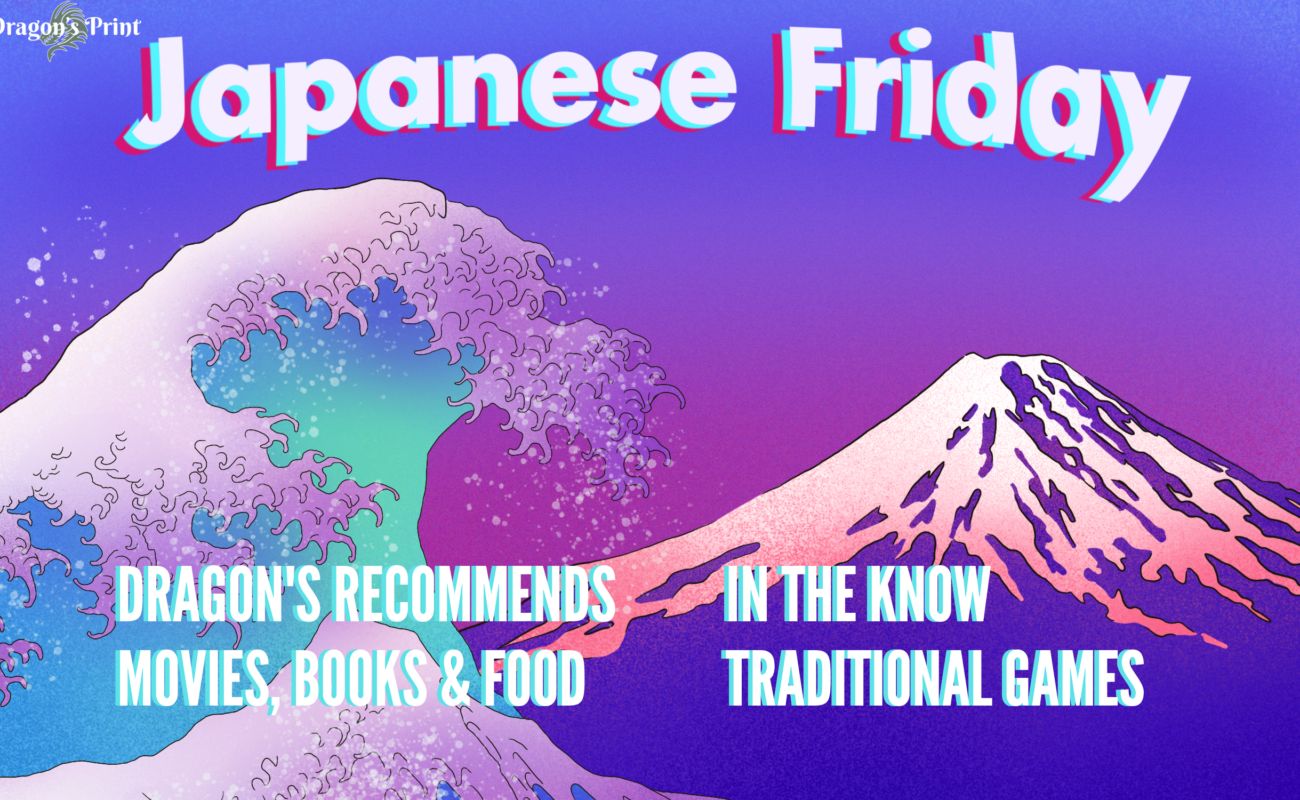Japan is known for many things, mostly its technology, food, and entertainment. For our last day of International Week, we will be recommending to you our top Japanese movies, foods, and books.
MOVIES
There are many fascinating Japanese movies, and the cool thing is that they come in all genres. If you like horror, we give you Ring (1998), famous for the character Sadako. If you’re more into historical or traditional movies, there’s Rurouni Kenshin (2012), Kagemusha (1980) or 13 Assassins (2010). Today, however, we will be focusing on two movies that we feel best showcase Japan’s cinematographic talents:
Spirited Away (2001)
Spirited Away (2001) is from the world-renowned animation studio, Studio Ghibli Inc. The film garnered international acclaim and was awarded Best Animated Feature at the 75th Academy Awards, the first hand-drawn non-English film to win the award. Despite its already massive success, we don’t want anyone to miss out on this amazing Japanese story.
Spirited Away is about a ten-year-old girl named Chihiro and her parents who stumble across an abandoned amusement park. Chihiro’s parents find a feast in a restaurant, and after stuffing themselves, things take a turn for the mystical and magical. She winds up working for a witch in a bath house for the supernatural. The young girl meets Haku, a mysterious spirit, who explains to her the strange world she stumbled into and how she can leave it a better person.
The movie is nostalgic yet thrilling, turning Japanese mythology and folklore into a visually stunning film. The director was able to build up the plot spectacularly; you can feel the sense of foreboding when Chihiro and her family unknowingly enter the spirit world. This grounded yet still fantastical movie gives you a sense of wonder as you’re pulled into Chihiro’s story. As we watch Chihiro’s growth from a naive child to a strong and unforgettable individual, we learn some meaningful insights on life and friendship. This quirky, timeless film teaches us that no matter how bad the world can get around you, it doesn’t hurt to work hard and be nice.
Koe no Katachi (2016)
This movie touches on some worldly and timeless themes of self-healing and development.
Koe no Katachi (A Silent Voice) revolves around Ishida Shouya, a former bully, and Nishimiya Shouko, a deaf girl. As elementary students, Ishida and his friends would constantly bully Nishimiya, who had just moved in. By saying snide comments behind her back, ripping her communication notebook, and even destroying her hearing aide multiple times, Ishida and his gang pushed Nishimiya to move away. However, once she was gone, karma stepped in and the bully became the bullied, as Ishida was ostracised for his actions. Seeking redemption, the boy’s first course of action is to now find Nishimiya and make amends for what he did to her in the past.
Both beautifully animated and powerfully made, this film can only be described as plaintive. Showing both sides of the story, everything is refreshingly laid out bare and the feelings of our characters freely pour out like a cascading waterfall. Something incredibly delicate and real about this story is the imperfections in the actions and feelings of the characters. For example, Ishida never regretted bullying Nishimiya until he himself was bullied, and that was when he realised the severity of his actions. Overall, Koe no Katachi is a painfully earnest movie about life and how hard yet worthwhile it is.
FOOD
Now, Japanese food is something we all know and love, but there is more to it than just sushi and ramen. To the Japanese, food means more than just filling your bellies; it’s about balance and blessings of the seasonal change. However, for today, we’re going to share some ‘unusual’ foods that you might not have tried before.
Natto
Our first dish isn’t really a dish; it’s more of a rice topping. It’s called natto, and it’s delicious but not really for everyone. It smells quite strong and would be strange if it didn’t, because natto is fermented soybeans mixed with soy sauce. However, those who enjoy this topping will usually eat this over rice with a side of grilled salmon and miso soup, making a healthy and balanced breakfast. Another way to eat natto — which is quite strange but is the way I like it— is over toasted bread with butter and mayonnaise. The cool thing about natto is that it’s incredibly good for your health, being not only cardiovascularly beneficial but also rich in Vitamin K2, which is essential for bone health.
Horumonyaki

Our second dish is already well-known. How do we explain what yakiniku is? It’s more than just barbecue– it’s on a whole different level. So let’s break it down simply: yakiniku literally translates to ‘grilled meat’. There are so many different cuts of meat you can order: there’s tan (beef tongue), karubi (boneless short ribs), harami (skirt steak) and rōsu (shoulder). However, we’re not going to talk about those well-known cuts of meat. Today, we’re going to be talking about horumonyaki, something most foreigners would call unusual or disgusting.
What is horumonyaki? To put it plainly, it’s animal entrails. It’s the innards of a chicken, pig or cow. That means things like intestines, hearts, livers, arteries, and even uteruses. Some yakiniku stores also offer brains or genitals, and even rectums.
Now before you turn your head and go “Ugh, that’s nasty”, horumonyaki is actually a Japanese delicacy and has a reputation for building stamina. There are so many benefits from eating horumon, and even if it sounds foul, it’s actually incredibly delicious and a horumon platter is something my friends and I order whenever we go to Japan’s yakiniku shops.
Another benefit of eating horumon is that liver is high in iron and has a rich, creamy texture that is absolutely amazing. There’s also marucho, Japanese for “small intestines”, which are a great source of collagen. Intestines are actually rich in B-vitamins, and overall, organ meat is a great source of protein. So next time you’re in Japan and you find yourself at a yakiniku store, be brave and order that platter of delicious cow offal.
BOOKS
Just like Japanese film and animation, Japanese books are equally as entertaining and astounding. There are so many good reads, like Kimi no Suizou Wo Tabetai, 102, and IQ84. However, these are our personal picks that we would like to share with you.
Itou Junji Kyoufu Manga Collection
The Itou Junji Kyoufu Manga Collection is a manga anthology not for the faint of heart – seriously, this is a warning. This is a collection of short stories by horror mangaka (a person who makes Japanese graphic novels) Junji Ito.
There’s no clear way to summarize the Junji Ito Collection other than it revolves around the theme of fear and its presence in our lives made fantastically grotesque. Junji Ito is a master artist in the literary and graphical field of making you want to bleach your eyes with holy water. His aesthetic comes mainly in distinctly morbid and horrifyingly detailed illustrations of body horror, a genre of horror involving deformed and warped human bodies. His unique, vivid, and downright creative images are basically in the form succinctly captured when you think of trypophobia (fear of small holes), but they’re in black and white and on steroids.
This isn’t to say that the collection is a nonsensical parade of grotesque images for the sake of making you horrified. It’s a thematically engaging collection of stories on the fears we all have over the equally horrific parade of grotesque but thought-provoking images which, at times, make you wish you were reading it in Braille.
Hachiko

Hachiko is a bittersweet story about the love and loyalty of a dog. Based off a true story, the book begins with a university professor named Eizaburo Ueno picking up a young puppy — an Akita Inu — left at the train station. Ueno brings the dog home and after seeing the tag with the number 8 on it, he decides to call him “Hachiko”, which is the Japanese word for “eight” with a suffix -ko at the end.
Ueno takes the train to work daily, and one day Hachiko follows him. Surprised, Ueno leaves the dog at the station, believing that he would return home. However, when he returned, Hachiko was still waiting for him at the station. It eventually became a habit for Hachiko to walk his owner to the train station, return home, then come pick Ueno up again once he’s finished with his work.
The book plot is a calm and peaceful one, almost slow and droll, mainly focusing on the bond between dog and master. However, the story of Hachiko ends in tragedy, and one that is guaranteed to make you cry. Hachiko’s never-ending fidelity to his master is a heartwarming one, and we strongly recommend this book to you. If you’d like, there’s also a movie version in English called Hachi: A Dog’s Tale.
References
The 75th Academy Awards: 2003. (n.d.). Retrieved from https://oscars.org/oscars/ceremonies/2003.
Article by Karen Y. (Grade 9) and Ikaia A. (Grade 11); Feature image by Karen Y.
Reviews are uncommissioned, unpaid, and represent the personal views of the author. They should not be taken to represent the views of Dragon’s Print and Cebu International School.
![]()




Leave a Reply